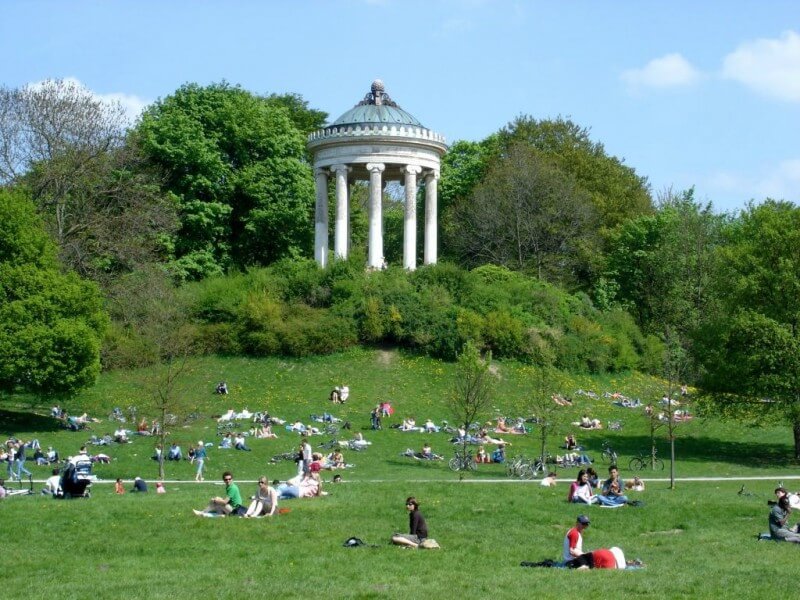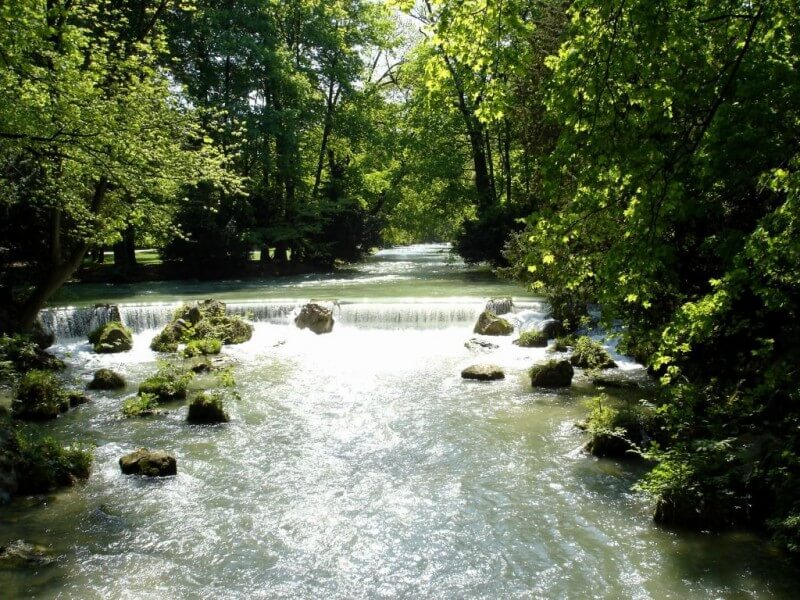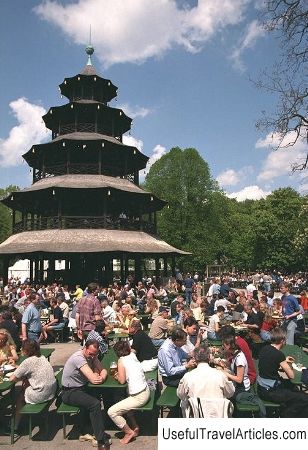English Garden in Munich, Germany, health resort Munich
Rating: 8,3/10 (5732 votes)  English Garden in Munich – one of the largest city parks in Europe and the world. The total area of the park & ndash; more than four sq. km. It stretches from the very center of the city to its northern outskirts for 5.5 km. The park was created by order of the Elector Karl Theodor in 1792 by Frederick Ludwig Szkel and was named in the architectural style of the English landscape park, used in its design. This style is the opposite of the pompous and symmetrical style of the French park. He strives for the most natural composition. The park became one of the first parks available to all comers in Europe today. The Munich English Garden occupies a larger area, than Central Park in New York and London's Hyde Park and is a favorite place for recreation and entertainment for residents and visitors alike. The park became famous thanks to its attractions: the Chinese Tower, the Monopter Pavilion, beer gardens. Over the years, the territory of the garden has been constantly expanding due to the addition of other parks to it. During the Second World War, the Monopter and the Chinese Tower were heavily damaged by bombing. The territories were cleared only in 1953, and school playgrounds were built on this site. Several times natural disasters damaged the garden: In 1964, 1988, 1990, hurricanes raged, knocking down many trees. All elms in the park have been destroyed by Dutch Elm Disease. The losses were compensated by a tree donation campaign organized by the city newspaper Abendzeitung, which planted more than 1,500 trees, 1,000 of which – elms, resistant elm diseases. There are a lot of water bodies in the park: von Schkelem created a network of streams and several lakes. They all continue the Munich underground system of streams, which are fed by the Izar. Eisbach, Schwabinger bach, Oberstagermeisterbach are among the most remarkable streams of the English Garden. Eisbach – the deepest stream in the English park. Surf lovers like to practice on it. In addition to streams, there are lakes, for example, the Kleinhessenloe, created in 1800. Its current area is over 85,000 sq. m. The lake is home to carp, pike and other noble fish species. There are three islands on the lake. Most of the attractions are located in the southern part of the garden. Among them are the Chinese Tower, the Monopter rotunda, the Japanese tea house, the Monument to the founder of the park, Friedrich Ludwig Schkel, the Rumfordhaus building in the Palladian style, the Stone Bench. In the northern part of the garden are the Sant'Emmeram Bridge, Amphitheater, Tivoli Power Station.      pikes and other noble fish species. There are three islands on the lake. Most of the attractions are located in the southern part of the garden. Among them are the Chinese Tower, the Monopter rotunda, the Japanese tea house, the Monument to the founder of the park, Friedrich Ludwig Schkel, the Rumfordhaus building in the Palladian style, the Stone Bench. In the northern part of the garden are the Sant'Emmeram Bridge, Amphitheater, Tivoli Power Station. pikes and other noble fish species. There are three islands on the lake. Most of the attractions are located in the southern part of the garden. Among them are the Chinese Tower, the Monopter rotunda, the Japanese tea house, the Monument to the founder of the park, Friedrich Ludwig Schkel, the Rumfordhaus building in the Palladian style, the Stone Bench. In the northern part of the garden are the Sant'Emmeram Bridge, Amphitheater, Tivoli Power Station.     pikes and other noble fish species. There are three islands on the lake. Most of the attractions are located in the southern part of the garden. Among them are the Chinese Tower, the Monopter rotunda, the Japanese tea house, the Monument to the founder of the park, Friedrich Ludwig Schkel, the Rumfordhaus building in the Palladian style, the Stone Bench. In the northern part of the garden are the Sant'Emmeram Bridge, Amphitheater, Tivoli Power Station. pikes and other noble fish species. There are three islands on the lake. Most of the attractions are located in the southern part of the garden. Among them are the Chinese Tower, the Monopter rotunda, the Japanese tea house, the Monument to the founder of the park, Friedrich Ludwig Schkel, the Rumfordhaus building in the Palladian style, the Stone Bench. In the northern part of the garden are the Sant'Emmeram Bridge, Amphitheater, Tivoli Power Station.     There are three islands on the lake. Most of the attractions are located in the southern part of the garden. Among them are the Chinese Tower, the Monopter rotunda, the Japanese tea house, the Monument to the founder of the park, Friedrich Ludwig Schkel, the Rumfordhaus building in the Palladian style, the Stone Bench. In the northern part of the garden are the Sant'Emmeram Bridge, Amphitheater, Tivoli Power Station. There are three islands on the lake. Most of the attractions are located in the southern part of the garden. Among them are the Chinese Tower, the Monopter rotunda, the Japanese tea house, the Monument to the founder of the park, Friedrich Ludwig Schkel, the Rumfordhaus building in the Palladian style, the Stone Bench. In the northern part of the garden are the Sant'Emmeram Bridge, Amphitheater, Tivoli Power Station.     There are three islands on the lake. Most of the attractions are located in the southern part of the garden. Among them are the Chinese Tower, the Monopter rotunda, the Japanese tea house, the Monument to the founder of the park, Friedrich Ludwig Schkel, the Rumfordhaus building in the Palladian style, the Stone Bench. In the northern part of the garden are the Sant'Emmeram Bridge, Amphitheater, Tivoli Power Station. There are three islands on the lake. Most of the attractions are located in the southern part of the garden. Among them are the Chinese Tower, the Monopter rotunda, the Japanese tea house, the Monument to the founder of the park, Friedrich Ludwig Schkel, the Rumfordhaus building in the Palladian style, the Stone Bench. In the northern part of the garden are the Sant'Emmeram Bridge, Amphitheater, Tivoli Power Station.     Most of the attractions are located in the southern part of the garden. Among them are the Chinese Tower, the Monopter rotunda, the Japanese tea house, the Monument to the founder of the park, Friedrich Ludwig Schkel, the Rumfordhaus building in the Palladian style, the Stone Bench. In the northern part of the garden are the Sant'Emmeram Bridge, Amphitheater, Tivoli Power Station. Most of the attractions are located in the southern part of the garden. Among them are the Chinese Tower, the Monopter rotunda, the Japanese tea house, the Monument to the founder of the park, Friedrich Ludwig Schkel, the Rumfordhaus building in the Palladian style, the Stone Bench. In the northern part of the garden are the Sant'Emmeram Bridge, Amphitheater, Tivoli Power Station.     Most of the attractions are located in the southern part of the garden. Among them are the Chinese Tower, the Monopter rotunda, the Japanese tea house, the Monument to the founder of the park, Friedrich Ludwig Schkel, the Rumfordhaus building in the Palladian style, the Stone Bench. In the northern part of the garden are the Sant'Emmeram Bridge, Amphitheater, Tivoli Power Station. Most of the attractions are located in the southern part of the garden. Among them are the Chinese Tower, the Monopter rotunda, the Japanese tea house, the Monument to the founder of the park, Friedrich Ludwig Schkel, the Rumfordhaus building in the Palladian style, the Stone Bench. In the northern part of the garden are the Sant'Emmeram Bridge, Amphitheater, Tivoli Power Station.     Japanese tea house, Monument to the founder of the park Friedrich Ludwig Schkel, building in the Palladian style Rumfordhaus, Stone bench. In the northern part of the garden are the Sant'Emmeram Bridge, Amphitheater, Tivoli Power Station. Japanese tea house, Monument to the founder of the park Friedrich Ludwig Schkel, building in the Palladian style Rumfordhaus, Stone bench. In the northern part of the garden are the Sant'Emmeram Bridge, Amphitheater, Tivoli Power Station.     Japanese tea house, Monument to the founder of the park Friedrich Ludwig Schkel, building in the Palladian style Rumfordhaus, Stone bench. In the northern part of the garden are the Sant'Emmeram Bridge, Amphitheater, Tivoli Power Station. Japanese tea house, Monument to the founder of the park Friedrich Ludwig Schkel, building in the Palladian style Rumfordhaus, Stone bench. In the northern part of the garden are the Sant'Emmeram Bridge, Amphitheater, Tivoli Power Station.     We also recommend reading Schleissheim Palace in Germany, Munich resort Topic: English Garden in Munich, Germany, health resort Munich. |




